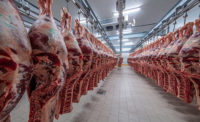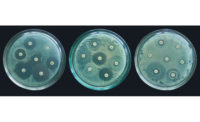Antimicrobial solutions are used to reduce contaminants on raw foods such as meats, vegetables and fruits. This is analogous to washing food prior to using it in one’s own kitchen, although these compounds enhance the washing action, says Martha Ewing, director of technical services at Sanderson Farms Inc., Laurel, Miss.
Antimicrobial solutions have proven to be very good at treating certain contaminants on animal carcasses and on primal and subprimal cuts, says Jim Dickson, a professor in the Department of Animal Science, Inter-Departmental Program in Microbiology, at Iowa State University in Ames.
“It’s one of the more significant introductions … in meat and poultry in the last 25 years,” he says. The statistics support that fact as well: Antimicrobial solutions are working.
According to the U.S. Department of Agriculture data for poultry, the Salmonella incidence rate has been reduced 26 percent from the beginning of 2013 and 55 percent compared to five years ago. Further, data indicates that the number expressed as a Most Probable Number of Salmonella is very low, less than 10 microorganisms when a positive result is enumerated, Ewing says.
One of the biggest challenges for processors of ready-to-eat (RTE) products that are exposed to the environment at packaging is the potential for Listeria monocytogenes contamination, explains Lynn Knipe, extension processed meats specialist and associate professor in Food Science and Technology, and Animal Sciences at Ohio State University in Columbus.
“For intact fresh cuts and for ready-to-eat products, surface contamination has been the greatest concern for processors, and I don’t see that changing in the near future,” says Knipe. “Since this is a surface contamination, sprays and dips can have the greatest impact on the surface contamination.”
Gaining ground
Newer compounds and application strategies are being developed for antimicrobial solutions. Lauric arginate, for example, was introduced in the United States a few years ago as an effective antimicrobial spray against Listeria.
“Lauric arginate may be sprayed directly on to RTE meat products prior to packaging, or sprayed inside the pouch before the meat product is inserted into the package,” Knipe says. “The latter option relies on the vacuum to distribute the lauric arginate uniformly around the packaged product. More recently, it has been shown to be effective as a surface treatment to eliminate Salmonella on chicken.”
Peroxyacetic acid is a new chemical that’s been widely used, especially in the beef industry, Dickson says. In the poultry industry, carcass washers apply sprays to both the inside and outside of the body cavity, as well as to the external surfaces, he says. One of the newest advancements in some poultry plants has been the use of a wash after the carcasses come out of the chiller.
“If you spray an organic acid on a poultry carcass and then you put it into a chiller, then it pretty much washes all of that off,” Dickson says. “There have been some that are using a wash or spray cabinet after carcasses come out of the chiller, and that seems to be pretty effective.”
The compounds commonly used today are considered processing aides and do not have a residual effect. If a residual effect was present, the compound would be considered an ingredient and would have to be included on the label.
Nevertheless, some clean-label products, which involve vinegar and lime juice, have been developed that are effective in eliminating surface contamination of both Listeria monocytogenes and C. perfringens on RTE meat products, Knipe says.
“With the consumer pressure for clean labels, these products provide the product safety needed [for processors and consumers], without chemical names that concern consumers,” he says.
Additionally, much work is being done in spices, botanicals, phyto-antimicrobials and phyto-chemicals to see if compounds can be isolated from various plants and/or seeds to have great antimicrobial effects, says Robert Gravani, a professor of food science in the Department of Food Science at Cornell University, Ithaca, N.Y.
“Certainly one of the areas that is being actively researched is the synergies that may develop between antimicrobials that are used in concert with each other,” he says. Research also needs to continue on antimicrobials to make sure they are still effective against the organisms to which they are targeted, he adds.
“Clearly one of the things in people’s minds is, ‘will there be new compounds coming in the future that will be even more efficacious than what we have now?’” Gravani says. “We’ve got to be constantly prospecting toward new compounds that will work that are as effective or more effective than the ones we have today.”
In addition, Ewing says, multiple points in each process are being evaluated for application effectiveness.
“The majority of these revolve around a water-based application, but other technologies are also being evaluated, such as UV light and high-pressure pasteurization,” she says. Antimicrobial solutions are being applied in more points during processing as well. For example, when organic acids first came out for beef carcass washes, they were only applied at the end of the process after the final carcass wash, Dickson says. Then some companies started applying them pre-evisceration, which is now pretty standard in the industry, he says. Now, companies are spraying carcasses when they come out of the coolers.
“In some cases, they are getting treated as many as three times with some of these antimicrobial solutions,” Dickson says. “It’s all with the idea of reducing the potential of contamination on the surface of the animal.”
The cost of some of these antimicrobial products may be keeping some processors from using them on their products though, Knipe adds. Still, the industry continues to look for new compounds and methods of antimicrobial wash application. As technology improves so will the ability of these compounds to reduce microbial contamination.
However, Ewing reminds that, while antimicrobial compounds can help reduce the level of microbes to almost undetectable levels, the product is not sterile. Safe food-handling techniques must be employed at all times when handling raw food.





Report Abusive Comment